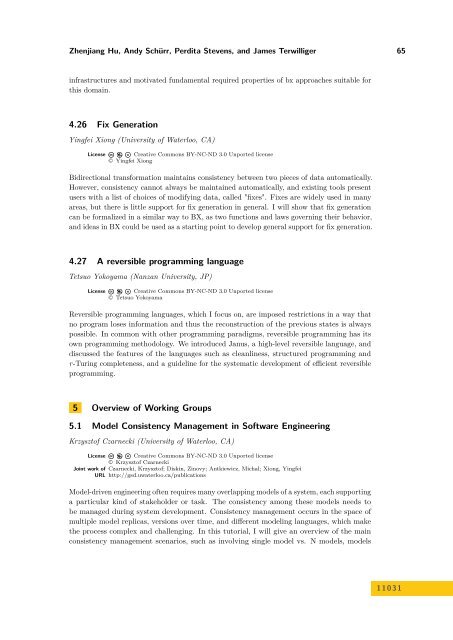Volume 1, Issue 1, January 2011 - DROPS - Schloss Dagstuhl
Volume 1, Issue 1, January 2011 - DROPS - Schloss Dagstuhl
Volume 1, Issue 1, January 2011 - DROPS - Schloss Dagstuhl
Create successful ePaper yourself
Turn your PDF publications into a flip-book with our unique Google optimized e-Paper software.
Zhenjiang Hu, Andy Schürr, Perdita Stevens, and James Terwilliger 65<br />
infrastructures and motivated fundamental required properties of bx approaches suitable for<br />
this domain.<br />
4.26 Fix Generation<br />
Yingfei Xiong (University of Waterloo, CA)<br />
License Creative Commons BY-NC-ND 3.0 Unported license<br />
© Yingfei Xiong<br />
Bidirectional transformation maintains consistency between two pieces of data automatically.<br />
However, consistency cannot always be maintained automatically, and existing tools present<br />
users with a list of choices of modifying data, called "fixes". Fixes are widely used in many<br />
areas, but there is little support for fix generation in general. I will show that fix generation<br />
can be formalized in a similar way to BX, as two functions and laws governing their behavior,<br />
and ideas in BX could be used as a starting point to develop general support for fix generation.<br />
4.27 A reversible programming language<br />
Tetsuo Yokoyama (Nanzan University, JP)<br />
License Creative Commons BY-NC-ND 3.0 Unported license<br />
© Tetsuo Yokoyama<br />
Reversible programming languages, which I focus on, are imposed restrictions in a way that<br />
no program loses information and thus the reconstruction of the previous states is always<br />
possible. In common with other programming paradigms, reversible programming has its<br />
own programming methodology. We introduced Janus, a high-level reversible language, and<br />
discussed the features of the languages such as cleanliness, structured programming and<br />
r-Turing completeness, and a guideline for the systematic development of efficient reversible<br />
programming.<br />
5 Overview of Working Groups<br />
5.1 Model Consistency Management in Software Engineering<br />
Krzysztof Czarnecki (University of Waterloo, CA)<br />
License Creative Commons BY-NC-ND 3.0 Unported license<br />
© Krzysztof Czarnecki<br />
Joint work of Czarnecki, Krzysztof; Diskin, Zinovy; Antkiewicz, Michal; Xiong, Yingfei<br />
URL http://gsd.uwaterloo.ca/publications<br />
Model-driven engineering often requires many overlapping models of a system, each supporting<br />
a particular kind of stakeholder or task. The consistency among these models needs to<br />
be managed during system development. Consistency management occurs in the space of<br />
multiple model replicas, versions over time, and different modeling languages, which make<br />
the process complex and challenging. In this tutorial, I will give an overview of the main<br />
consistency management scenarios, such as involving single model vs. N models, models<br />
1 1 0 3 1













